Not everything is bigger in the Lone Star State
Texas has a reputation for all things big: longhorns, 10-gallon hats, big hair, big oil, big steaks, big expanses and a big howdy. Its embrace of the measure is iconic. But what most impressed me on a stubbornly rainy April trip through southeast Texas was the tiny – the birds, the blooms and the small parks and attractions that put the sprinkles on top.
Still, there was no escaping the big Texas miles. My husband and I plotted a generous loop from the Hill Country to the Gulf Coast to the Rio Grande, with wiggle room for distractions and whims of adventure. A purchase of the annual state-park pass helped the cause.
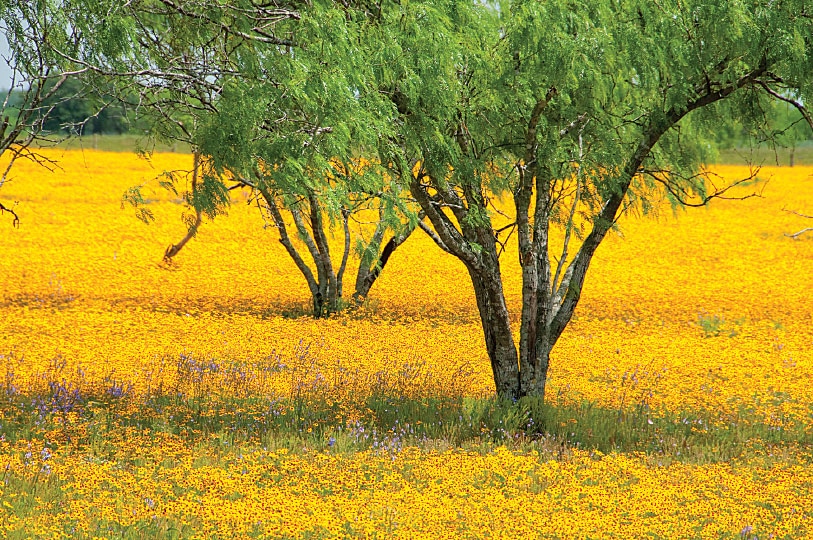
his yellow daisy field among mesquite trees was a beautiful site in Goliad County.
Hill Country
Spring put Texas bluebonnets on the agenda. Seduced long ago by an image of President Lyndon B. Johnson (LBJ) and his Lady Bird striding through a riot of blooms, I was primed to be wowed. Despite not finding the border-to-border bloom of my imagination or even that of Texas tourism, I wasn’t disappointed.
From the windshield, we saw rangeland painted in lavender verbena and bold seedings of bluebonnet and Indian paintbrush. With regular traffic flow and the narrow road shoulders, parks and public lands provided the safe stops to admire. Best in show for natural displays came at Kerr Wildlife Management Area (WMA) and at Inks Lake State Park.
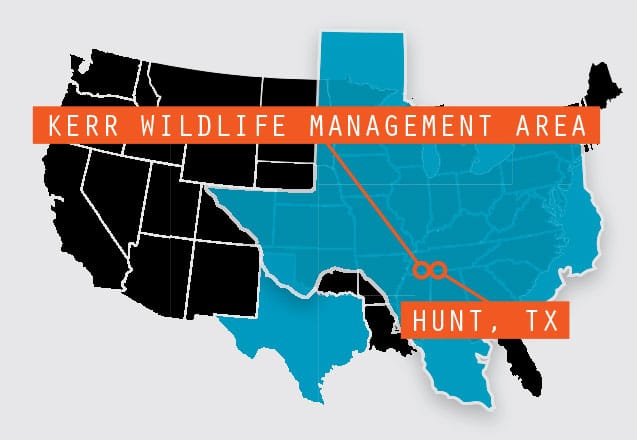
Getting There
Kerr Wildlife Management Area (WMA) is located about 80 miles northwest of San Antonio, in Kerr County. Take Interstate 10 to Kerrville and turn west (south) on state Highway 16, then connect with Highway 27 on the south side of Kerrville. Turn right on Highway 27 heading toward Ingram. In Ingram, take Highway 39 west another 7 miles to Hunt. Go through Hunt on Rural Route 1340 northwest for 12 miles to the Kerr WMA entrance.
For the WMA, our dinghy vehicle eased parking and turnarounds. Also, we had to time visits to avoid the closures for turkey hunts. But the added effort rewarded with rolling quilts of bluebonnets, pierced by cacti, nolina and twisted yucca.
On foot, we traced an old Jeep track over a rise and into the WMA. The floral bonanza ran through oak woodlands and spilled across grassy sweeps. We alternated from upright surveys to hands-and-knees study, lingering until the canteen ran dry.
Inks Lake holds camping and offers fine park paths to roam and admire the bloom. Habitats of open rock, meadow and woodland vary the presentation. Besides the bluebonnet and the rosy Indian paintbrush, we encountered a flower-petal rainbow: multicolored Indian blanket, yellow coreopsis, white prickly poppy and burgundy winecup. Cacti suggested we pay better attention, but offered claret cups and yellow blooms in consolation.
Throughout Hill Country, state-park and natural-area camping served our needs: Garner, Lost Maples and South Llano River. Before hunting bluebonnets, flights of scarlet tanagers, cardinals and vermilion flycatchers bounced my gaze from shrub to canopy. Park blinds and feeders facilitated spying. Hummingbirds, golden-cheeked warblers and local species (new to us) added to our list. Volunteers maintaining feeders and regular visitors shared viewing tips and bird identifications.
Regional darlings, Stonehenge II and the companion Easter Island heads, celebrate second life at Hill Country Arts Foundation (HCAF; 830-367-5121, www.hcaf.com) in Ingram. The stucco-and-plaster reproduction of the 5,000-year-old English religious/astronomical wonder again rises from an open field. The island heads with elongated features resume watch.
Like others, we first met Al Shepperd’s unusual replications years ago while driving FM (farm-to-market road) 1340, and we suffered rubberneck for the unexpectedness. When henge and heads faced destruction, HCAF offered rescue and relocation, now welcoming the public to its campus for viewing during daylight hours, donation optional. The parking lot for the visual and performing arts center accommodates motorhomes. Visitors are free to wander, photograph and respectfully admire the fanciful pairing.
Wonderful small history parks add to the Texas archive. At the Fort Croghan/Burnet County Heritage Society, we rummaged unhurried through the indoor museum, but a downpour kept us from the actual fort. Weather cooperated at the Fort McKavett State Historic Site, allowing us to walk among its white adobe structures, ruins and foundations.
At 150 years old, McKavett stands as the best remaining fort from the Texas-Indian wars. It occupies open ground on a mild rise with area views. Strolls took us past the hospital building, dead house, Lieutenants Row, barrack ruins, bakery, shops and school. Buffalo soldiers for a time resided at the fort. We had the fort to ourselves … sharing only with the ghosts of the past.
While most things LBJ are monumental in size, I gravitated toward the quiet attractions of his boyhood home in Johnson City and the Sauer-Beckmann living history farm, part of his namesake state park. The latter looked at farm life in the Hill Country at the turn of the 20th century. Great attention was given to method, tools and supplies of the era. Among pantry canned goods were items preserved in lard. In the kitchen, women kneaded bread, snapped beans and cooked on a wood stove. LBJ was greatly influenced by family tales of early settlement, hardship and American Indian encounters.
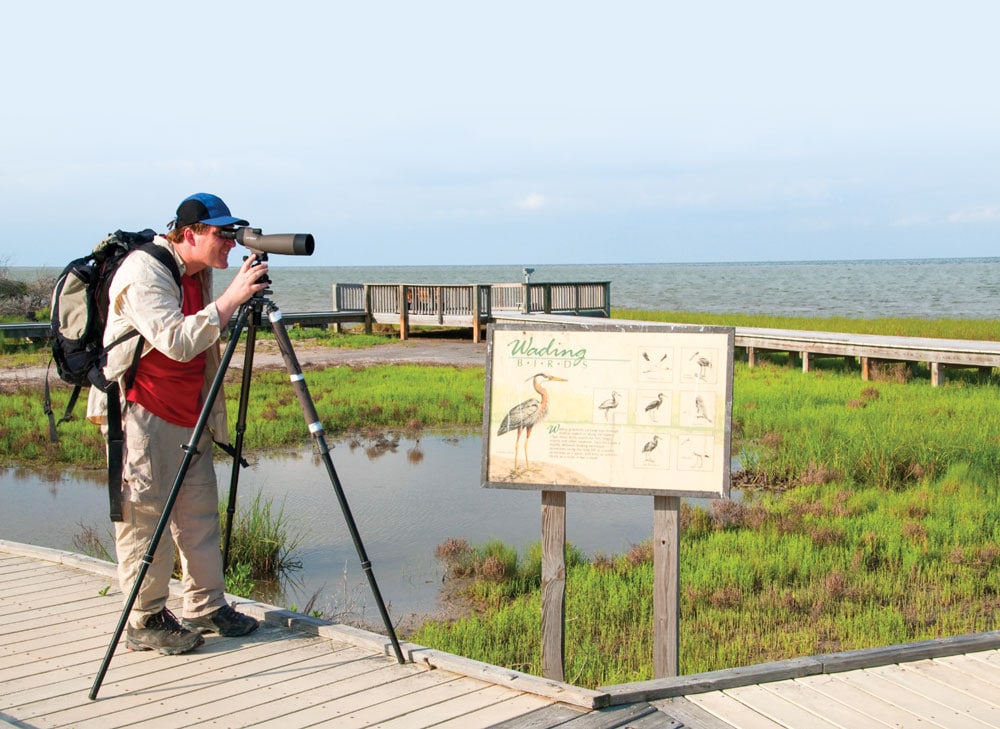
Birding is a popular activity along the boardwalk at Aransas National Wildlife Refuge.
Gulf Coast
Golden fields addressed our sightseeing route to the coast. Goliad State Park and Historic Site on U.S. Highway 183/77A took us into the 18th-century Spanish Colonial fort-and-mission period of Texas.
Rebuilt by the Civilian Conservation Corps (CCC), Mission EspÃritu Santo enchanted with its elegant simplicity and purpose. An attentive ranger explained the symbolism. We learned about the settlement roles of the Spanish military and the Catholic church, area ranching and the life of American Indian converts.
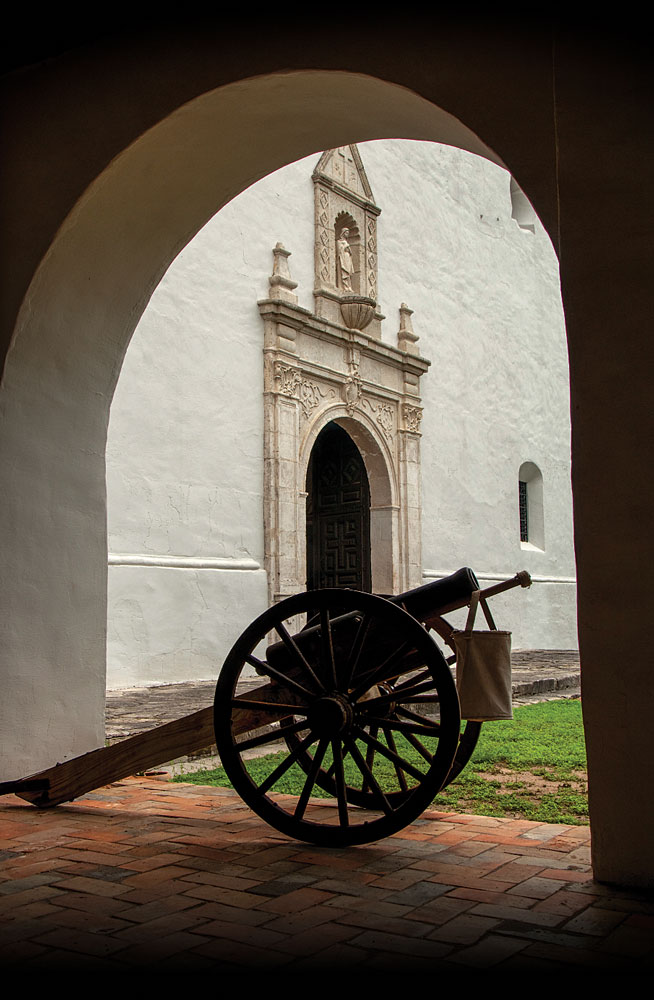
This cannon can be found at Mission EspÃritu Santo, which relocated to Goliad in 1749.
To the mission’s south sits the fort, Presidio La BahÃa, with its heavy studded gates, towers, and cannon and gun openings. The nine flags at its entry recall the political changes under which it stood.
Nearby sites dedicated to Col. James W. Fannin and Gen. Ignacio Zaragoza continued our Texas history lesson. Wildflowers sprinkled the revered grounds. During the Texas Revolution, “Remember Goliad!” was a cry as fervor-fanning and dear as that for the Alamo. Fannin and his men were held at the fort before Gen. Antonio Lopez de Santa Anna’s ordered execution of them. Fannin Battleground and Memorial Monument fleshed out the story.
Zaragoza was the Texas-Mexican hero who defeated the French at the Battle of Puebla in 1862. Cinco de Mayo honors that victory. His reconstructed birthplace sits near the presidio.
At Corpus Christi, South Texas Botanical Gardens and Nature Center provided us a pleasing escape on a humid afternoon. The compact garden delighted with songbirds and butterflies as well as blooms and attractive plants. Orchids and bromeliads seemed appropriate for the day.
At the coast, Goose Island State Park, Padre Island National Seashore, Aransas National Wildlife Refuge and Laguna Atascosa National Wildlife Refuge drew us in. The big-name locations welcomed with grand and textured landscapes, but the birds stole the show.
We encountered birds more suited south of the border, some heading north, and some native. We watched and listened to the Bonaparte and laughing gulls, saw herons catch fish, and listened as turnstones gave endorsement to their names. We spied scissor-tailed flycatchers and indigo buntings. Chachalacas, with the pterodactyl-worthy, air-splitting calls, surprised us with their partridge size. Crested caracaras, spotted sandpipers, green jays, reddish egrets, roadrunners and more kept us on the search.
We traveled on pier, boardwalk, nature trail, and we mowed track and roadway, visiting gulf and bay shores, pond, salt marsh, desert, woodland and prairie. Palmetto State Park, Goose Island, and Padre Island sheltered us at night.
With management closure of Bayside Drive, a tram tour operates at Laguna Atascosa.
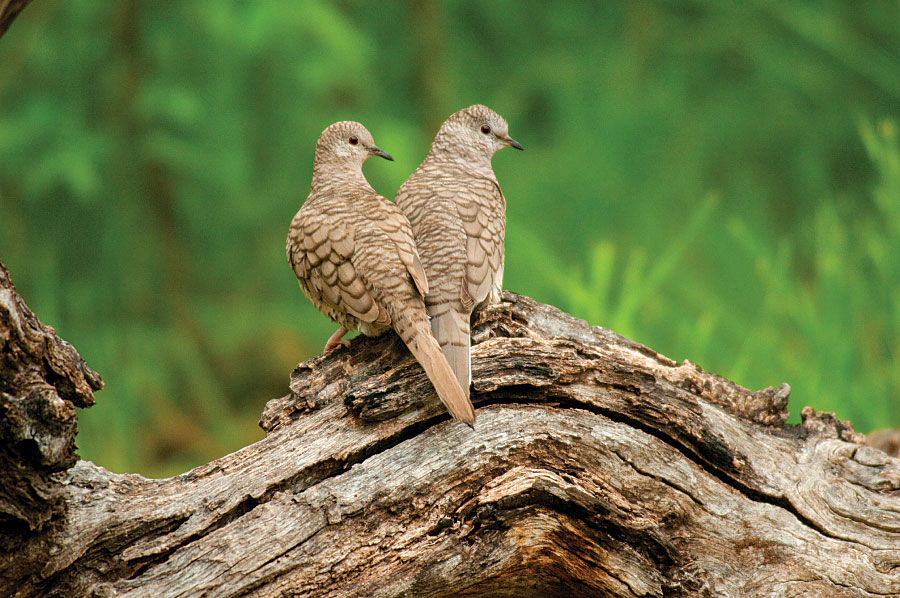
A pair of Inca dove perch on a felled log at South Llano River State Park.
Rio Grande
As we wend toward the great river border, north of Brownsville along FM 1847, Palo Alto Battlefield National Historical Park bade us aside. On the Palo Alto prairie, on May 8, 1846, the United States and Mexican troops first tangled in a war that would ultimately establish the Rio Grande as the U.S. southern border and lead to Mexico’s surrender of one-third of its territory: much of California, Utah, Nevada, Arizona and New Mexico.
History panels and a walking tour of the site laid out the battle. Battlefields of the Rio Grande were proving grounds for military leaders who would go on to Civil War fame.
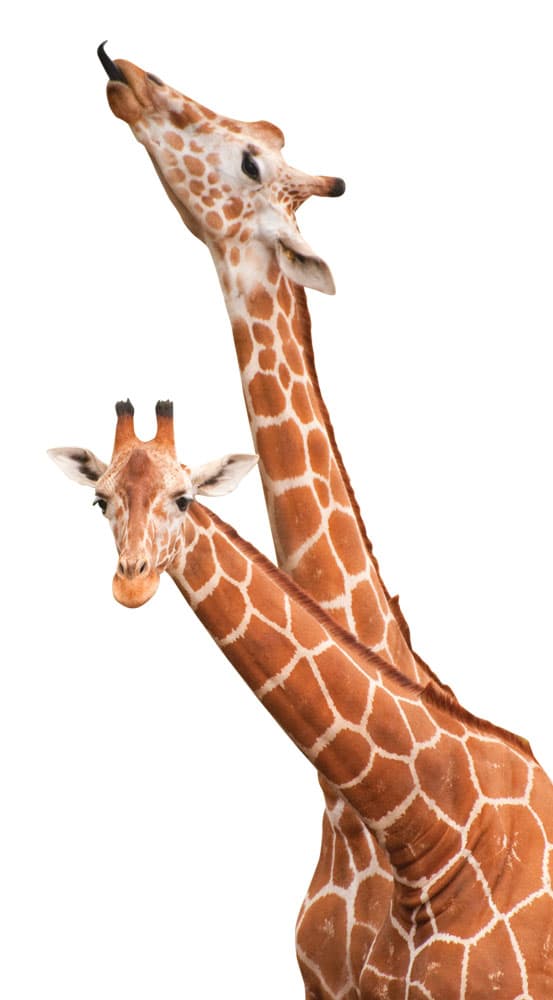
Brownsville’s Gladys Porter Zoo has been smartly appointed with habitats that benefit the residents, like these charming giraffes.
Within 31 acres, the Gladys Porter Zoo in Brownsville stands toe to toe with some of the best zoos in the nation. It may be my all-time favorite. The National Zoo may be special with its North American wildlife, and for animal welfare, the San Diego and Columbus zoos are top-notch. But for sheer enjoyment, ease of viewing and attractive enclosures that benefit animals, the Gladys Porter Zoo nails it.
The collection holds both popular and seldom-seen animals. Shade trees and water elements add to the zoo’s appeal, as does one of the nicest giraffe exhibits I’ve seen. The census lists lowland gorilla, flamingo, lemur, oryx, kudu, bontebok, bearded pig, long-legged crane and hornbill. Drop-in black-bellied whistling ducks and great egrets voluntarily stick around.
Tropical birds were the mission of our Rio Grande travel. After searching via tram, path and canopy walk at Santa Ana National Wildlife Refuge, we took the quest to Bentsen-Rio Grande Valley State Park. It is home to the World Birding Center Headquarters, one of nine specially recognized birding sites in the Rio Grande Valley. A tram shuttles between the site visitor center and park interior.
We had wanted to see the Rio Grande but it was too hot to hike. As it was, we alone rode the tram, our reward seeing javelina and coyote. With only a walk-in tent camp at the park, private RV parks met overnight needs.
Edinburg Scenic Wetlands, another of the World Birding Centers, wrapped up the journey. It offered a good-size lake, nature paths and center exhibits. Push-buttons gave voice to select bird species. Several of them, we had already encountered. Others we must meet another time. But returning to Texas is a small sacrifice.
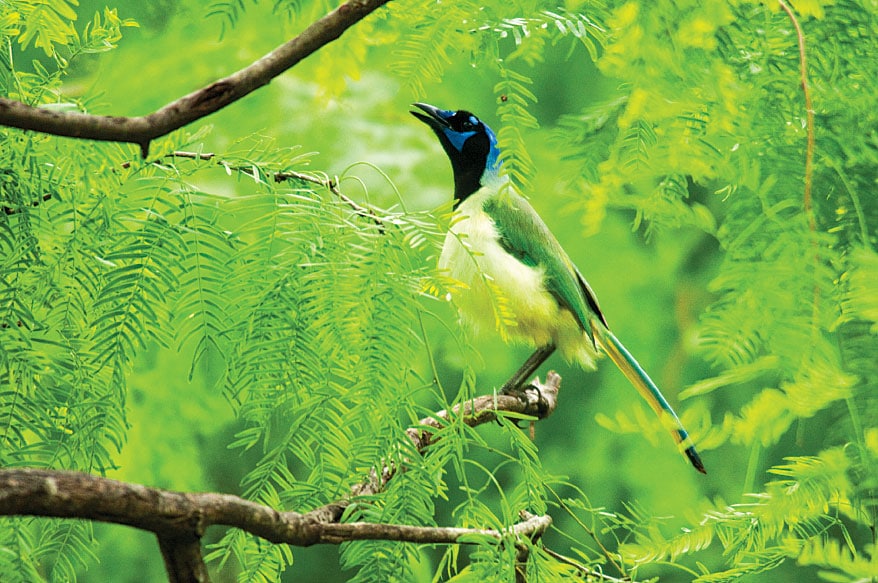
A green jay serenades visitors at Laguna Atascosa National Wildlife Refuge.
For More Information
Travel Texas | 800-452-9292 | www.traveltex.com
Texas Parks and Wildlife | 512-389-4800; 800-792-1112 | http://tpwd.texas.gov
U.S. Fish and Wildlife Service (National Wildlife Refuge System) | www.fws.gov/refuges
National Park Service | www.nps.gov

